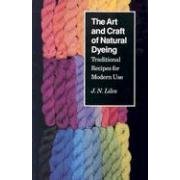I cooked some purple cauliflower for dinner and the water turned a lovely royal blue. Can I use the water to dye wool or silk?
I cooked some purple cauliflower for dinner and the water turned a lovely royal blue. Can I use the water to dye wool or silk?
Name: Ann
—ADVERTISEMENTS—
Books About Natural Dyes
The Art and Craft of Natural Dyeing:
Traditional Recipes for Modern Use
by Jim Liles
Country or region: Canada
Message: I cooked some purple cauliflower for dinner and the water turned a lovely royal blue. Can I use the water to dye wool or silk? What mordant would I use? I did a google search and found nothing.
Thank you for such an informative site and blog.
The pigment in purple cauliflower comes from anthocyanin pigments, similar to those in blueberries and red grapes. Unfortunately, the pigments in these foods perform poorly as textile dyes. On exposure to oxygen, light, and the laundry, they turn to pale dull grayish or brown colors, sadly nothing like the beautiful blue that inspired this question. There is no mordant that will be able to retain the blue color long-term. I don't recommend dyeing any textile fiber with anthocyanin-based natural dyes, except possibly for very temporary experiments. The only plant-based blue dye I can wholeheartedly recommend is indigo, a substance found in something like fifty species of plants around the world.
Since anthocyanins are water soluble, they tend to leach out into the cooking water. If you want to experiment to see how much more brilliant a color you can retain in your cooked purple cauliflower, try cooking with as little water as possible. I like to cut up enough broccoli or cauliflower florets to fill a two-quart lidded glass pot, adding no water at all, and then microwave on high for approximately five minutes, or until a fork can easily pierce through, watching closely the first time to make sure not to cook for too long. I think that cabbage-family vegetables taste best when cooked without water, or when cooked with a small amount of fat (such as butter or olive oil) in place of water, and doing so will help to retain as much color as possible.
The color in purple cauliflower is related to that found in purple cabbage. It's interesting to note that the color of these pigments changes as the pH (level of acidity) changes. If you lower the pH by adding a mild acid, such as lemon juice or vinegar, the color will change to become more red or more pink. Your cooking water turned blue because it is either neutral in pH, or slightly alkaline. If you increase the pH by adding a basic substance such as baking soda (not nearly so good-tasting, and it can destroy some vitamins when cooked with vegetables), the color will change to be more blue. If you add a much stronger base than you would ever use in preparing food at home, such as washing soda or caustic soda, the blue/red anthocyanin pigments can even turn green.
For a related question, see the September 7, 2008 entry in my dyeing blog, "Dyeing with beautiful blue butterfly pea flowers". For examples of poor results obtained when dyeing with the anthocyanins found in beets, see a Dye Forum entry from January 2006, "Beets as a natural dye".
Posted: Friday - August 27, 2010 at 08:25 AM
Follow this blog on twitter here.
Quick Links
- All About Dyes & Dyeing Top -
- Top of this blog -
- FAQ -
- The Dye Forum -
- How to Tie Dye - How to Batik -
- Books - Toys - Plants -
- Top of this blog -
- FAQ -
- The Dye Forum -
- How to Tie Dye - How to Batik -
- Books - Toys - Plants -
More in this category:
- -
Statistics
Total entries in this blog:
Total entries in this category:
Published On: Aug 29, 2012 02:49 PM
Total entries in this category:
Published On: Aug 29, 2012 02:49 PM

